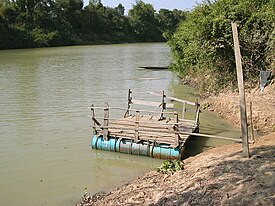Chi River
| Chi River (Mae Si) | |
|
Ferry, Chi River
|
|
| Mouth | |
|---|---|
| - location | Mun river, Sisaket Province |
| - elevation | 110 m (361 ft) |
| Length | 1,047 km (651 mi) |
| Basin | 49,480 km2 (19,104 sq mi) |
| Discharge | for Yasothon |
| - average | 290 m3/s (10,241 cu ft/s) |
| - max | 3,960 m3/s (139,846 cu ft/s) |
|
Map of the Mun River watershed showing the Chi River
|
|
The Chi River (Thai: แม่น้ำชี, rtgs: Maenam Chi, IPA: [mɛ̂ːnáːm tɕʰīː]) is the longest river flowing wholly within Thailand. It is 765 kilometres (475 mi) long but carries less water than the second longest river, the Mun. The name of the river is "Mae Si" ([sīː]) in the Isan and Lao languages of the region, being transliterated as "Chi" in Bangkok-Thai. In wet seasons there are often flash floods in the floodplain of the Chi River basin.
The river rises in the Phetchabun mountains, then runs east through the central Isan provinces of Chaiyaphum, Khon Kaen, and Maha Sarakham, then turns south in Roi Et, runs through Yasothon and joins the Mun in the Kanthararom district of Sisaket Province. The river carries approximately 9.3 cubic kilometres (2.2 cu mi) of water per annum.
The river was an 18th-century migration route for the re-peopling of the Khorat Plateau by ethnic Lao people from the left (east) bank of the Mekong resettling on the right bank. This began in 1718 when the first king of the left bank Kingdom of Champasak, King Nokasad, sent a group of some 3,000 subjects led by an official in his service to found the first settlement in the Chi River valley—and indeed anywhere in the interior of the Khorat Plateau—Muang Suwannaphum in present-day Roi Et Province (a history recorded and remembered, largely in terms of the struggle to expand wet-rice cultivation in the river valley). Their descendants are now regarded as a separate ethnic group from the Lao to the north and the central Thai to the southwest.
...
Wikipedia


